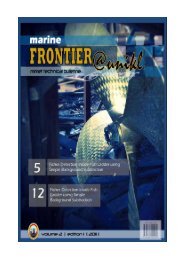click here to download - UniKL MIMET Official Website
click here to download - UniKL MIMET Official Website
click here to download - UniKL MIMET Official Website
Create successful ePaper yourself
Turn your PDF publications into a flip-book with our unique Google optimized e-Paper software.
PDE equations (1) and (2). Comparisons between<br />
simulation and experiment results are as shown in<br />
Figure 4.<br />
Figure 4: Comparisons between Simulation and Experiment<br />
Results (PS=Simulated Pressure)<br />
DISCUSSION<br />
The transmission line diameter calibration experi‐<br />
ment shows that the relationship between the di‐<br />
ameter and the exerted pressure is close <strong>to</strong> linear.<br />
This is then applied <strong>to</strong> the simulation algorithm <strong>to</strong><br />
investigate the influence of the working pressure<br />
on the transmission line diameter expansion as<br />
shown in Figure 2.<br />
Figure 3 shows the pressure response in the<br />
transmission line after the valve is closed. When<br />
the valve is fully closed, the air will continue <strong>to</strong><br />
flow downstream of the transmission line due <strong>to</strong><br />
the presence of higher pressure and momentum<br />
at the upstream of the transmission line. T<strong>here</strong>‐<br />
fore the pressure downstream of the transmis‐<br />
sion line will continue <strong>to</strong> increase until it reaches<br />
a peak value at which the velocity downstream is<br />
close <strong>to</strong> zero. The fluid then starts <strong>to</strong> flow in the<br />
opposite direction in the transmission line since<br />
the pressure downstream is larger than the pres‐<br />
sure upstream. When the upstream pressure<br />
reaches new peak value, the fluid flows down‐<br />
stream again. This process repeats itself though<br />
the peak pressure values reached as the time<br />
progresses at different transmission line posi‐<br />
tions will gradually decreases due <strong>to</strong> the viscosity<br />
effect imposed on the travelling air. Finally, the<br />
system reaches a new steady state in which all<br />
the pressures along the transmission line arrived<br />
at a same constant value.<br />
A combined transmission line model is proposed<br />
in this paper. The simulation is based on the com‐<br />
bination of finite difference model McCloy (1980)<br />
and lumped model (Xue and Yusop, 2005). The<br />
lumped model is used <strong>to</strong> update the boundary<br />
<strong>MIMET</strong> Technical Bulletin Volume 1 (2) 2010<br />
conditions, which is then applied <strong>to</strong> the first and<br />
the last segments. The parameters for the other<br />
segments are updated by means of finite differ‐<br />
ence model in the simulation algorithm.<br />
Simulation results show good consistency com‐<br />
pared with the experiment data especially in the<br />
pressure frequency response. The simulation re‐<br />
sults also show that the air in the transmission<br />
line <strong>to</strong>ok a longer time <strong>to</strong> reach a new steady<br />
state compared with the experiment results. This<br />
is due <strong>to</strong> the fact that perfect gas is assumed. Per‐<br />
fect gas assumes that the force between the at‐<br />
oms or molecules in the gas is negligible. The oc‐<br />
cupied volume of the a<strong>to</strong>ms or molecules in the<br />
gas is also omitted under perfect gas conditions.<br />
On the other hand, under real gas conditions, due<br />
<strong>to</strong> the existence of the aforementioned fac<strong>to</strong>rs,<br />
the influence of friction on the working fluid is<br />
larger. Furthermore when the a<strong>to</strong>ms or molecules<br />
in the air hit the blocked end of the transmission<br />
line with a certain momentum, some of these at‐<br />
oms or molecules are bounced back from the<br />
blocked end of the transmission line which is in<br />
the opposite direction of the air flow. The direct<br />
influence of this is a reduction in the <strong>to</strong>tal air en‐<br />
ergy and this result in an earlier dissipation of the<br />
pressure wave in the captured data compared <strong>to</strong><br />
the simulated results.<br />
CONCLUSION<br />
A time domain model describing the dynamics of air<br />
in a pneumatic transmission line is presented by con‐<br />
sidering changes in air density, pressure and mass<br />
flow rate. The combined models are proposed <strong>to</strong><br />
simulate the dynamics of trapped air in a blocked<br />
transmission line. In order <strong>to</strong> update the boundary<br />
conditions, the first and the last segments are consid‐<br />
ered as two lumped volumes and these are then con‐<br />
nected <strong>to</strong> the transmission line segments using an<br />
orifice model. The transmission line segments are<br />
expressed by means of finite difference model. The<br />
effectiveness of the proposed model is depicted<br />
| MARINE FRONTIER @ <strong>UniKL</strong><br />
111



